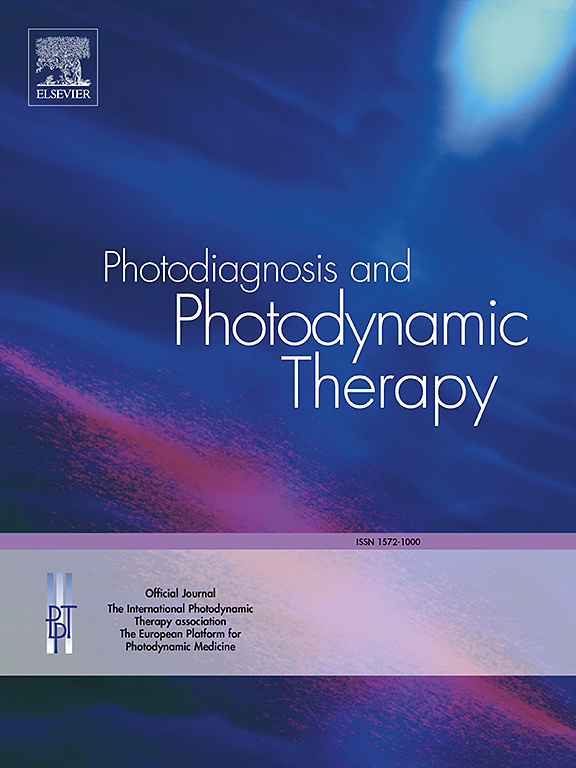Second harmonic generation-mediated Photodynamic Therapy for Staphylococcus aureus: A novel approach using Bismuth Ferrite-Protoporphyrin IX conjugates
IF 3.1
3区 医学
Q2 ONCOLOGY
引用次数: 0
Abstract
Photodynamic therapy (PDT) is a minimally invasive treatment modality that utilizes photosensitizing agents, light, and molecular oxygen to produce cytotoxic reactive oxygen species (ROS) to treat cancerous cells and bacterial infections. However, the effectiveness of PDT is often limited by the penetration depth of the light used to activate the photosensitizer (PS). We propose an effective method to address this challenge using Second Harmonic Generation (SHG), a nonlinear optical process in which two identical photons combine to form a new photon with double the frequency. This technique enables the utilization of longer wavelengths for enhanced tissue penetration, subsequently converting them into shorter wavelengths that align with the absorption characteristics of the photosensitizer. Thus, to achieve a highly effective production of SHG, we successfully synthesized the Harmonic Nanoparticle (HNP), Bismuth Ferrite (BFO). Subsequently, BFO was conjugated with Protoporphyrin IX (PPIX) to get BFO-PPIX conjugates for PDT treatment. These were exposed to Near Infrared (NIR) femtoseconds pulsed laser with a wavelength of 798 nm. PDT experiments using BFO-PPIX conjugates and an 8-minute irradiation by a 798 nm pulse laser reduced the survival rate of cultured Staphylococcus aureus (S. aureus) bacterial cells to 44.5 % ± 3.4 %. To the best of our knowledge, BFO and BFO-PPIX conjugates have not been used previously for advancing the conventional PDT treatment using SHG for deeper and precise treatment in S. aureus.
二次谐波产生介导的光动力治疗金黄色葡萄球菌:使用铁酸铋-原卟啉IX偶联物的新方法。
光动力疗法(PDT)是一种微创治疗方式,利用光敏剂、光和分子氧产生细胞毒性活性氧(ROS)来治疗癌细胞和细菌感染。然而,PDT的有效性通常受到用于激活光敏剂(PS)的光的穿透深度的限制。我们提出了一种有效的方法来解决这一挑战,使用二次谐波产生(SHG),这是一种非线性光学过程,其中两个相同的光子结合形成一个频率加倍的新光子。该技术能够利用较长的波长来增强组织穿透,随后将其转换为与光敏剂的吸收特性一致的较短波长。因此,为了实现高效生产SHG,我们成功地合成了谐波纳米粒子(HNP),铋铁氧体(BFO)。随后,BFO与原卟啉IX (PPIX)偶联得到BFO-PPIX偶联物用于PDT治疗。这些被暴露在近红外(NIR)飞秒脉冲激光的波长为798纳米。使用BFO-PPIX偶联物和798 nm脉冲激光照射8分钟的PDT实验将培养的金黄色葡萄球菌(S. aureus)细菌细胞的存活率降低到44.5%±3.4%。据我们所知,BFO和BFO- ppix缀合物以前尚未用于推进使用SHG对金黄色葡萄球菌进行更深入和精确治疗的传统PDT治疗。
本文章由计算机程序翻译,如有差异,请以英文原文为准。
求助全文
约1分钟内获得全文
求助全文
来源期刊

Photodiagnosis and Photodynamic Therapy
ONCOLOGY-
CiteScore
5.80
自引率
24.20%
发文量
509
审稿时长
50 days
期刊介绍:
Photodiagnosis and Photodynamic Therapy is an international journal for the dissemination of scientific knowledge and clinical developments of Photodiagnosis and Photodynamic Therapy in all medical specialties. The journal publishes original articles, review articles, case presentations, "how-to-do-it" articles, Letters to the Editor, short communications and relevant images with short descriptions. All submitted material is subject to a strict peer-review process.
 求助内容:
求助内容: 应助结果提醒方式:
应助结果提醒方式:


